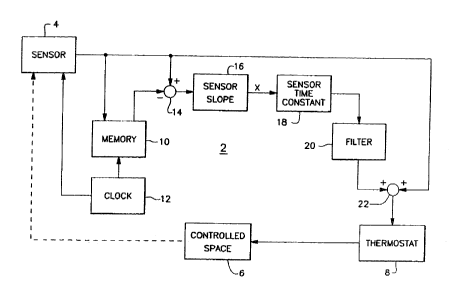Some of the information on this Web page has been provided by external sources. The Government of Canada is not responsible for the accuracy, reliability or currency of the information supplied by external sources. Users wishing to rely upon this information should consult directly with the source of the information. Content provided by external sources is not subject to official languages, privacy and accessibility requirements.
Any discrepancies in the text and image of the Claims and Abstract are due to differing posting times. Text of the Claims and Abstract are posted:
| (12) Patent: | (11) CA 2000854 |
|---|---|
| (54) English Title: | COMPENSATION CIRCUIT FOR SENSOR LAG TO REDUCE UNDERSHOOT AND OVERSHOOT |
| (54) French Title: | CIRCUIT DE COMPENSATION ANTI-POMPAGE POUR CAPTEURS THERMIQUES |
| Status: | Deemed expired |
| (52) Canadian Patent Classification (CPC): |
|
|---|---|
| (51) International Patent Classification (IPC): |
|
| (72) Inventors : |
|
| (73) Owners : |
|
| (71) Applicants : | |
| (74) Agent: | SMART & BIGGAR |
| (74) Associate agent: | |
| (45) Issued: | 1997-12-23 |
| (22) Filed Date: | 1989-10-17 |
| (41) Open to Public Inspection: | 1990-06-14 |
| Examination requested: | 1996-02-08 |
| Availability of licence: | N/A |
| (25) Language of filing: | English |
| Patent Cooperation Treaty (PCT): | No |
|---|
| (30) Application Priority Data: | ||||||
|---|---|---|---|---|---|---|
|
A compensation circuit for sensor lag uses a sensor
temperature signal modification circuit to provide a
modified sensor temperature signal for subsequent use in
controlling the sensed temperature. The compensation
circuit digitally compares a current sensor temperature
representative signal and a sensor temperature signal at a
last or preceeding sample time to produce a difference
signal which is converted to a sensor slope signal and is
multiplied by a sensor time constant. The resulting signal
is passed through a filter to eliminate transient effects
and is summed with the original sensor temperature signal to
provide a sensed temperature signal for control of the
temperature whereby the sensed temperature is a better
estimate of the actual environmental temperature controlled
by a thermostat utilizing the sensed temperature signal.
Circuit de compensation de retard de détecteur, utilisant un circuit de modification de signal de température de détecteur afin de produire un signal modifié qui servira à régler la température détectée. Le circuit de compensation compare numériquement un signal indiquant la température d'un détecteur à un moment donné et un signal indiquant la température du détecteur au temps d'échantillonnage le plus récent ou précédent afin de produire un signal différentiel qui est converti en un signal de pente de détecteur et multiplié par une constante de temps du détecteur. Le signal ainsi produit est filtré afin d'éliminer les phénomènes transitoires puis additionné au premier signal de température de détecteur pour produire un signal de température détectée qui servira à régler la température, la température détectée offrant une meilleure estimation de la température ambiante réelle réglée par un thermostat.
Note: Claims are shown in the official language in which they were submitted.
Note: Descriptions are shown in the official language in which they were submitted.

For a clearer understanding of the status of the application/patent presented on this page, the site Disclaimer , as well as the definitions for Patent , Administrative Status , Maintenance Fee and Payment History should be consulted.
| Title | Date |
|---|---|
| Forecasted Issue Date | 1997-12-23 |
| (22) Filed | 1989-10-17 |
| (41) Open to Public Inspection | 1990-06-14 |
| Examination Requested | 1996-02-08 |
| (45) Issued | 1997-12-23 |
| Deemed Expired | 2006-10-17 |
There is no abandonment history.
| Fee Type | Anniversary Year | Due Date | Amount Paid | Paid Date |
|---|---|---|---|---|
| Application Fee | $0.00 | 1989-10-17 | ||
| Registration of a document - section 124 | $0.00 | 1990-02-26 | ||
| Maintenance Fee - Application - New Act | 2 | 1991-10-17 | $100.00 | 1991-09-27 |
| Maintenance Fee - Application - New Act | 3 | 1992-10-19 | $100.00 | 1992-09-28 |
| Maintenance Fee - Application - New Act | 4 | 1993-10-18 | $100.00 | 1993-09-27 |
| Maintenance Fee - Application - New Act | 5 | 1994-10-17 | $150.00 | 1994-09-22 |
| Maintenance Fee - Application - New Act | 6 | 1995-10-17 | $150.00 | 1995-09-20 |
| Maintenance Fee - Application - New Act | 7 | 1996-10-17 | $150.00 | 1996-09-20 |
| Final Fee | $300.00 | 1997-07-07 | ||
| Maintenance Fee - Application - New Act | 8 | 1997-10-17 | $150.00 | 1997-10-01 |
| Maintenance Fee - Patent - New Act | 9 | 1998-10-19 | $150.00 | 1998-09-30 |
| Maintenance Fee - Patent - New Act | 10 | 1999-10-18 | $200.00 | 1999-10-04 |
| Maintenance Fee - Patent - New Act | 11 | 2000-10-17 | $200.00 | 2000-09-20 |
| Maintenance Fee - Patent - New Act | 12 | 2001-10-17 | $200.00 | 2001-09-19 |
| Maintenance Fee - Patent - New Act | 13 | 2002-10-17 | $200.00 | 2002-09-18 |
| Maintenance Fee - Patent - New Act | 14 | 2003-10-17 | $200.00 | 2003-09-17 |
| Maintenance Fee - Patent - New Act | 15 | 2004-10-18 | $450.00 | 2004-09-16 |
Note: Records showing the ownership history in alphabetical order.
| Current Owners on Record |
|---|
| HONEYWELL INC. |
| Past Owners on Record |
|---|
| BECKEY, THOMAS J. |